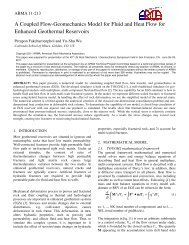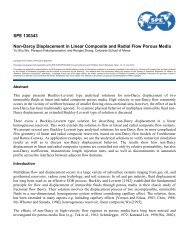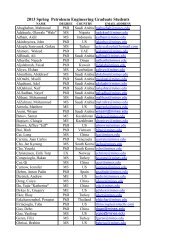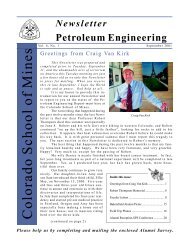SPE 146840 Pilot Testing Issues of Chemical EOR in Large ...
SPE 146840 Pilot Testing Issues of Chemical EOR in Large ...
SPE 146840 Pilot Testing Issues of Chemical EOR in Large ...
You also want an ePaper? Increase the reach of your titles
YUMPU automatically turns print PDFs into web optimized ePapers that Google loves.
6 <strong>SPE</strong> <strong>146840</strong>Capillary or Bond number. For IFT <strong>in</strong>terpolation versus concentration we used work done by Gupta and Mohanty, 2008, andfor residual oil saturation versus Capillary number we used work presented by Kamath et al., 2001. Surfactant concentrationis calculated <strong>in</strong> matrix and fracture <strong>in</strong> both implicit and explicit formulations.Figure 4 shows the recovery factor and <strong>in</strong>cremental oil recovery for 1000 days <strong>of</strong> water flood followed by 300 days <strong>of</strong>surfactant flood. Surfactant <strong>in</strong>jection <strong>in</strong> a water <strong>in</strong>vaded zone us<strong>in</strong>g dual-porosity model results <strong>in</strong> a very low <strong>in</strong>cremental oilrecovery, here is less than one percent. Because <strong>of</strong> oil-wet nature <strong>of</strong> carbonate reservoir negative capillary pressure isovercom<strong>in</strong>g the other two mechanisms; gravity and viscous displacement forces. Gravity force is negligible at the end <strong>of</strong>waterflood because fractures around matrix blocks are mostly full <strong>of</strong> water. Pressure difference between matrix and adjacentfractures are very small, so viscous forces also are not effective. Therefore fluid exchange will not take place <strong>in</strong> an effectiveway to carry enough surfactant <strong>in</strong>to the matrix block. Eq. 15 was used to calculate the capillary pressure <strong>in</strong> presence <strong>of</strong>surfactant. At high concentrations IFT can reduce capillary pressure to zero.IFT surfPcsurf Pc S(15)or sfIFT<strong>in</strong>itialWhere, Pc (surf) is the capillary pressure <strong>in</strong> presence <strong>of</strong> surfactant, and Sor sf is the new residual oil saturation calculated atthat grid. In wettability-<strong>in</strong>duced <strong>in</strong>cremental oil recovery, it is believed that at high concentrations surfactant can change thecapillary pressure values <strong>in</strong>to positive values. This results <strong>in</strong> complete or partially alter<strong>in</strong>g the wettability <strong>of</strong> the rock. In thispaper we used assumptions based on the surfactant concentration to change the capillary pressure (Eq. 16).Maximum shift( 0.5 psi)Pc ( surf ) Pc Sor C(16)sfsgridCs<strong>in</strong>jectionWhere Cs <strong>in</strong>jection is the concentration <strong>in</strong> <strong>in</strong>jection well, Cs grid is the concentration <strong>in</strong> each grid. Based on the concentration <strong>in</strong>each grid a vlue between 0 to 0.5 psi will be added to the capillary pressure at that node. This method is just anapproximation. Another work to model the wettability alteration by chang<strong>in</strong>g the capillary pressure based on concentrationwas done by Farhad<strong>in</strong>ia and Delshad, 2010. The maximum negative capillary at the end <strong>of</strong> water flood <strong>in</strong> our system isaround -0.15 psi. For example for concentration <strong>of</strong> 4000 ppm, capillary at wettability alteration condition will be +0.05 psi <strong>in</strong>that grid.Figure 4. Recovery factor dur<strong>in</strong>g water-flood and <strong>in</strong>cremental oil recovery for IFT <strong>in</strong>duced andwettability altered surfactant <strong>in</strong>jection <strong>in</strong> dual-porosityCase 2: Dual-porosity matrix ref<strong>in</strong>ement formulationDual-porosity model does not produce <strong>in</strong>cremental oil recovery dur<strong>in</strong>g surfactant <strong>in</strong>jection. After water flood<strong>in</strong>g all fracturesare nearly full <strong>of</strong> water, therefore gravity force will not be effective to help surfactant penetrate <strong>in</strong>to the matrix. On the otherhand viscous force (pressure gradient) is negligible. Therefore, the only mechanism rema<strong>in</strong>s is capillary pressure but oil-wetnature <strong>of</strong> the fractured reservoir makes it hard for surfactant to penetrate <strong>in</strong>to matrix block. We believe that <strong>in</strong> a real situationsurfactant might only can touches the surface or a very shallow deep <strong>of</strong> the matrix. To be more realistic we chose matrixref<strong>in</strong>ement approach to <strong>in</strong>vestigate the effect <strong>of</strong> ref<strong>in</strong>ement on both water flood<strong>in</strong>g and surfactant <strong>in</strong>jection. In this method wekept the same matrix block size (20ft <strong>in</strong> all directions) and ref<strong>in</strong>ed it <strong>in</strong>to sub-<strong>in</strong>ternal-blocks. A schematic view <strong>of</strong> one nestedmatrix block is shown <strong>in</strong> Figure 5. In this figure orig<strong>in</strong>al matrix block is divided <strong>in</strong>to three nested blocks.









